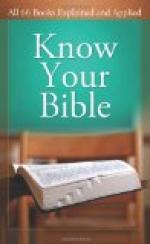5. Directions for building the tabernacle, Chs. 25-31.
6. The covenant broken and renewed, Chs. 32-34.
7. The erection and dedication of the Tabernacle, 35-40.
For Study and Discussion. (1) The preparation of Israel and Moses for the deliverance. (2) The conception of God found in Exodus: (a) As to his relation to nature, (b) As to his relation to his enemies, (c) As to his relation to his people, (d) As to his nature and purposes. (3) The conception of man found in Exodus. (a) The need and value of worship to him, (b) His duty to obey God. (4) The plagues. (5) The divisions of the decalogue: (a) Those touching our relation to God. (b) Those touching our relation to men. (6) The different conferences between Jehovah and Moses, including Moses’ prayer. (7) The current evils against which the civil laws were enacted and similar conditions of today. (8) The character of the different persons mentioned in the book: (a) Pharaoh, (b) Moses, (c) Aaron, (d) Jethro, (e) Magicians. (8) Amalek, etc. (9) The Messianic teachings of the book-here study (a) the sacrifices, (b) the material, colors, etc., of the Tabernacle, (c) the smitten rock, (d) Moses and his family.
* * * * *
Chapter III.
Leviticus.
Name. By the rabbis, it was called “The Law of the Priest” and “The Law of Offerings,” but from the time of the Vulgate it has been called Leviticus, because it deals with the services of the sanctuary as administered by the Levites.
Connection with Former Books. In Genesis, man is left outside of the Garden and the remedy for his ruin is seen in the promised seed. In Exodus, man is not only outside of Eden, but is in bondage to an evil enemy and his escape from his bondage is shown to be in the blood of the lamb, which is shown to be sufficient to satisfy man’s need and God’s justice. In Leviticus there is given the place of sacrifice, as an atonement for sin, and it is shown that God accepted the sacrifice of the victim instead of the death of the sinner. It is a continuation of Exodus, containing the Sinaitic legislation from the time of the completion of the Tabernacle.
Contents. Except the brief historical sections found in chapters 8-10 and 24:10-14, it contains a system of laws, which may be divided into (1) Civil, (2) Sanitary, (3) Ceremonial, (4) Moral and (5) Religious laws, emphasis being placed on moral and religious duties.
Purpose. (1) To show that God is holy and man is sinful. (2) To show how God can maintain his holiness and expose the sinfulness of man. (3) To show how a sinful people may approach a Holy God. (4) To provide a manual of law and worship for Israel. (5) To make Israel a holy nation.
Key-Word. The key-word then is Holiness, which is found 87 times in the book, while in contrast with it, the words sin and uncleanliness (in various forms) occur 194 times, showing the need of cleansing. On the other hand, blood, as a means of cleansing, occurs 89 times. The key verse is, I think, 19:2, though some prefer 10:10 as the best verse.




